Welcome back! Last time, I’ve spent a lot of time looking back at some past cards that are playable in the Expanded format. This time, why not look ahead at the future instead? The next mini-set, Paldean Fates, releases at the end of the month, on January 26. It will be tournament legal two weeks later, on February 9 — just in time for Dortmund Regionals in Germany.
Let’s manage our expectations here: I don’t expect Paldean Fates to have a major impact on the metagame. Most of its cards are reprints of existing cards. For collectors, there’s a lot to enjoy — and many players will love to bling out their deck with shiny versions of Pokémon like Ditto, Spiritomb, and Mimikyu, not to mention fantastic Special Illustration Rare cards such as Gardevoir ex, Penny and Arven. But are there new cards poised to see play? Yes, of course. Just like Crown Zenith, which was released last year at about the same time, Paldean Fates may not have many new cards, but some of them could be big. (As a reminder, Crown Zenith was mostly reprints too, but just after its release, Azul Garcia Griego won the Oceania International Championships with a Sky Seal Stone in his deck.)
Let’s talk about the cards from Paldean Fates that players can look forward too.
1. The small improvements
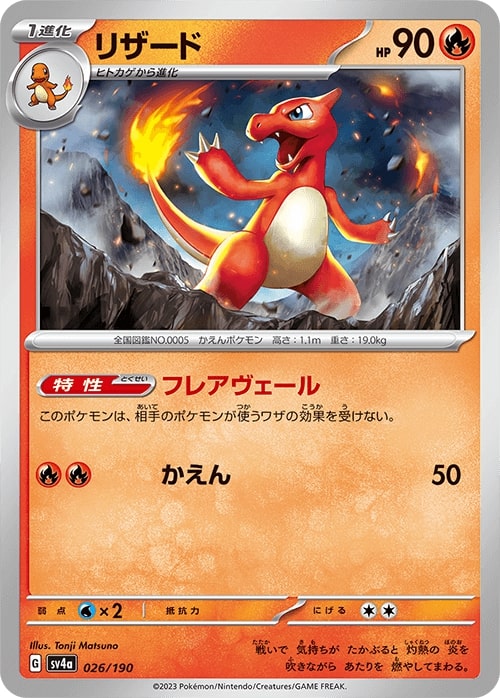

First, let’s talk about some cards that are not particularly impressive, but which will see play nonetheless. The first one is Charmeleon, which has an Ability that protects it from effects of attacks (such as Sableye’s Lost Mine). I used to think that it was better to play a 100 HP Charmeleon, and I still think it is in the Bibarel / TM Evolution variant of Charizard… but the Pidgeot ex variant is more popular, and Azul Garcia Griego recently won San Antonio Regionals with a list that included two Level Ball and a 90 HP Charmeleon. I’d expect anyone playing a similar list to replace the Obsidian Flames Charmeleon with the Paldean Fates Charmeleon, because that Ability can sometimes be relevant.
Similarly, the new Frigibax from Paldean Fates has Collect to draw a card for one Energy. It’s a very marginal improvement over the Paldea Evolved Frigibax, as you’re not exactly hoping to attack to Frigibax, and many players choose the 60 HP Frigibax for its lower retreat cost anyway. That being said, having at least one 70 HP Frigibax is nice to avoid some issues like Sableye using Lost Mine to KO two Frigibax. An in the cases when you go second and open with it, having Collect is nice. So while Frigibax will not change the face of the game, it’s still a very playable card.
Also relevant is Atticus, a promo Supporter from Japan that was never released until now. It’s a fantastic draw Supporter which allows its player to shuffle their hand into their deck and draw seven cards, but it can only be played if the opponent’s Active Pokémon is Poisoned. This card is very relevant in one deck: Klawf / Hisuian Electrode V. This deck aims to poison both Active Pokémon with Brute Bonnet and Hisuian Electrode V every turn, and it needs powerful draw cards, so Atticus is a perfect fit. In theory, you could also play the card in versions of Roaring Moon ex that also play the Brute Bonnet + Ancient Booster Energy Capsule combo, but Roaring Moon tries to play Professor Sada’s Vitality most of the time, so Atticus is not as good there.
Finally, I want to mention Kilowattrel, which gives the United Wings deck, a new attacker that can hit the Bench. United Wings is not really relevant right now, but if it comes back at some point (which could happen if a new card with United Wings is released, for example), Kilowattrel would likely see play in the deck, as a 1-of.
2. Moonlit Hill
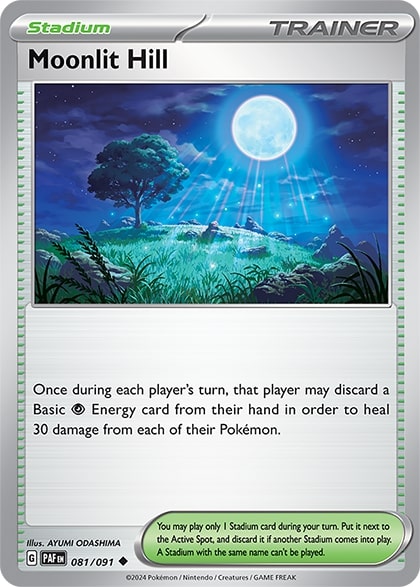
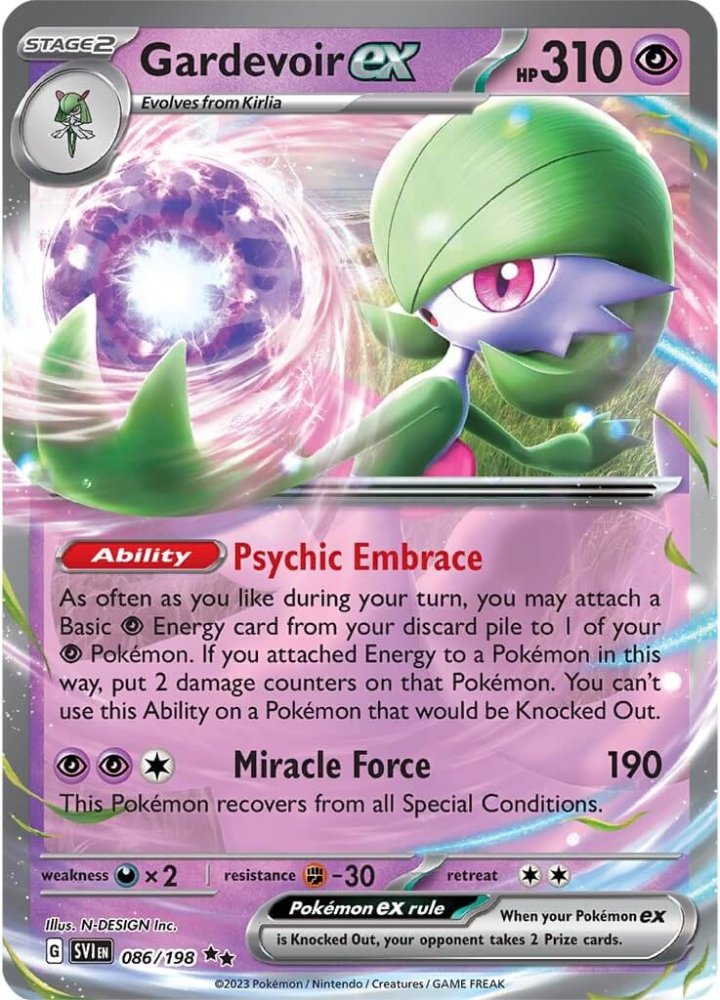
Moonlit Hill is a long-awaited Stadium that’s been legal in Japan for months, and that’s been played in almost every Gardevoir ex decklist there since its release. When Moonlit Hill is in play, you can discard a Psychic Energy from your hand to heal 30 damage from all your Pokémon. The synergy in Gardevoir ex is fantastic. Here are some uses for it:
- Discard Energy faster. Sometimes, you can get stuck with a lot of Energy in hand, and no way to discard it (or maybe you can use Refinement, but you’re going to play Iono and would rather use Refinement afterwards). Moonlit Hill lets you discard one more Energy, which can help to reach a key damage threshold early on.
- Deal more damage. Champions Festival has sometimes been used for this purpose: attach six Energy to a Gardevoir, heal 10 damage from it, attach an extra Energy. Moonlit Hill does the same, except it heals more, so you can attach two more Energy from the discard. This means that you can attach nine Psychic Energy to a 140 HP Gardevoir in one turn. Decks like Charizard ex would sometimes play around Gardevoir by tieing it on Prizes, preventing the use of Reversal Energy. With Moonlit Hill, even that doesn’t prevent the Gardevoir player from dealing 330 damage in one turn with Brainwave from an empty board, without needing to hit an Energy off Shining Arcana!
- Attach extra Energy. This is not as impressive, but with Moonlit Hill, you can attach an Energy to several of your Pokémon, then heal the damage put on all of these Pokémon. This can be used in the early game to spread Energy on multiple Ralts/Kirlia so they can attack more easily when they evolve. Also, you can put an Energy on Mew for the next time you want to retreat with it.
- Heal damage. Yeah, you can actually heal damage dealt by your opponent, not just by yourself! Combine Moonlit Hill and Cresselia and you can get rid of a lot of damage counters in one turn, which is perfect against Sableye and Rapid Strike decks.
All in all, Moonlit Hill is a great card that will see play in Gardevoir ex as a 1- or 2-of. Will it be enough to solve the deck’s issues? It’s unclear, but it should definitely make it a stronger play.
3. Technical Machine: Crisis Punch
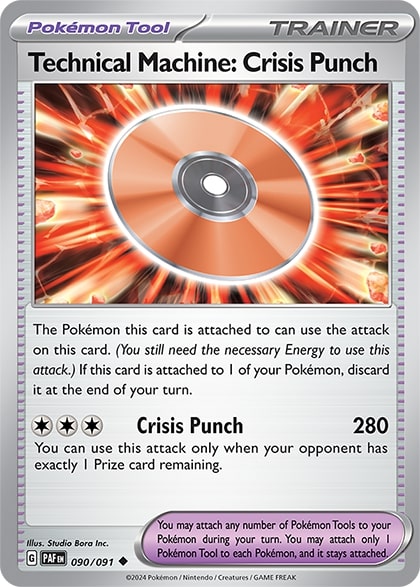
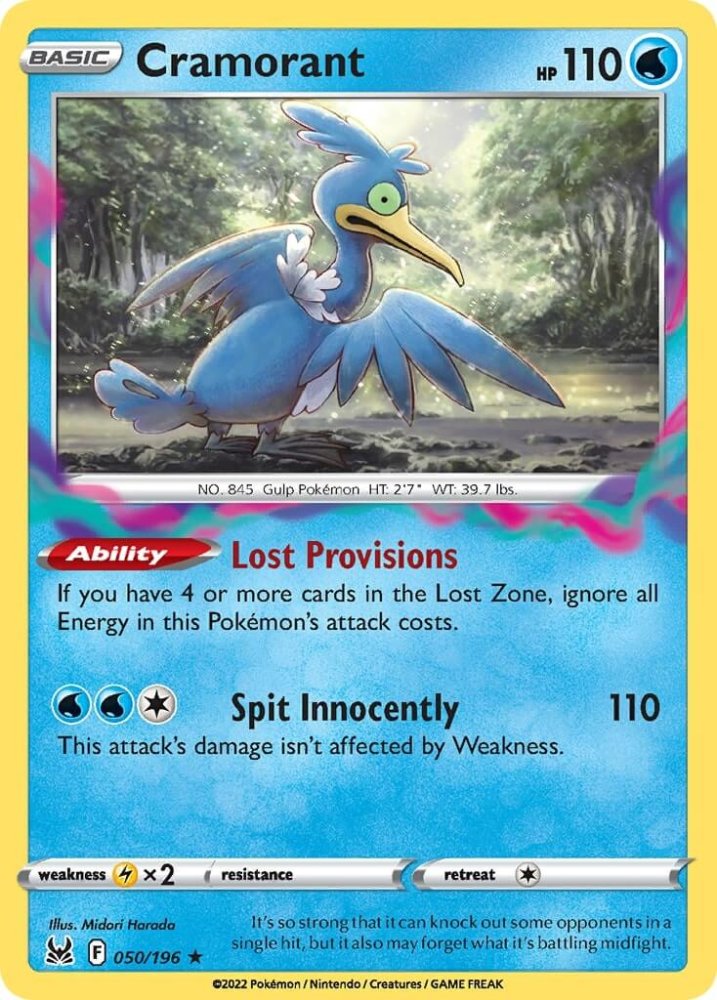
As good as Moonlit Hill is, TM Crisis punch has my vote for most impactful card of the set. Crisis Punch deals 280 damage for three Energy, and can only be used if the opponent has one remaining Prize. Which decks can use it?
Lost Box, for one. Cramorant’s Ability lets it attack for free when you have four cards or more in the Lost Zone, and that includes attacks from Technical Machines. This means that it can use Crisis Punch for no Energy. This is reminiscent of Radiant Charizard: a powerful attacker that can only be used late in the game (Radiant Charizard takes up the Radiant slot and deals 30 fewer damage, but it can also attack earlier in the game, and be used multiple times thanks to Super Rod and Klara). In fact, Crisis Punch can easily fit into a Sableye / Radiant Charizard deck, giving it multiple ways to deal high damage (fun fact, Radiant Charizard’s Ability also allows it to use Crisis Punch for free by the time the opponent has taken five Prizes). Here’s a sample list:
| Pokemon | Trainers | Energy |
|---|---|---|
| 4 Comfey LOR 79 | 4 Colress’s Experiment LOR 155 | 3 Psychic Energy |
| 3 Cramorant LOR 50 | 2 Raihan CRZ 140 | 2 Fire Energy |
| 2 Sableye LOR 70 | 2 Klara CRE 145 | 1 Double Turbo Energy BRS 151 |
| 1 Radiant Charizard CRZ 20 | 1 Roxanne ASR 150 | |
| 1 Manaphy BRS 41 | 4 Battle VIP Pass FST 225 | |
| 1 Jirachi PAR 126 | 4 Switch Cart ASR 154 | |
| 1 Spiritomb PAL 89 | 4 Escape Rope BST 125 | |
| 4 Nest Ball SVI 181 | ||
| 2 Pokégear 3.0 SVI 186 | ||
| 2 Super Rod PAL 188 | ||
| 2 Lost Vacuum CRZ 135 | ||
| 2 Counter Catcher PAR 160 | ||
| 1 Hisuian Heavy Ball ASR 146 | ||
| 1 Mirage Gate LOR 163 | ||
| 1 Pal Pad SVI 182 | ||
| 1 Technical Machine: Devolution PAR 177 | ||
| 1 Technical Machine: Crisis Punch | ||
| 3 Beach Court SVI 167 |

This list is heavily based off of Christian Fontenot’s, who won Stuttgart Regionals, but with a TM Crisis Punch over the second TM Devolution, and a third Cramorant to trade more effectively in the early game, and to use Crisis Punch in the late game more easily.
Of course, SableZard is far from the only deck that can play Crisis Punch. Other versions of Lost Box, especially those who play Town Store, can also make good use of it, although of course, it doesn’t fit as well in Kyogre decks, because Kyogre is usually a better finisher than Crisis Punch if you’re bothering to build around it.
What about non-Lost Box decks? While many decks have the Energy acceleration required to power up Crisis Punch, most of them have better attacking options. Gardevoir ex can usually power up a Gardevoir or Zacian V to deal 280 damage or more. Charizard ex will deal 330 damage by the time the opponent has one Prize left. Chien-Pao ex doesn’t need Crisis Punch to reach 280 damage, and so on. The fact that Crisis Punch can be played on any Pokémon opens up some possibilities, though, in the case Crisis Punch doesn’t end the game. Here’s one such idea that was posted on Twitter by Japanese player Koichi Kimura: you can play Mimikyu V and TM Crisis Punch in Gardevoir. Let’s say you find yourself at four remaining Prizes against one against a Miraidon deck (this can often happen if they start taking Prizes early on with Iron Hands ex). You can play Mimikyu V with TM Crisis Punch, power up the attack with Psychic Embrace, and take a KO on Iron Hands ex or some other two-Prizer. Thanks to Mimikyu V’s Dummy Doll Ability, it’s protected from damage. Play Iono at the same time to make it harder for the opponent to find a Boss’s Orders for game. Then, on the next turn, simply KO another two-Prize Pokémon with Gardevoir or Zacian V for game!
This scenario is a little specific and Crisis Punch hasn’t seen significant play in Japan to my knowledge, so it’s probably not good enough to run, but hopefully you can see its potential even outside of Lost Box.
4. Espathra ex
Espathra ex is far less relevant to the metagame than the other cards mentioned, but it could see still some play, especially among rogue players. It has an interesting combination of traits: an Ability that makes it harder for opponents to attack, an attack with an unlimited damage cap, a useful Grass typing, as well as the possible inclusion of Paradox Rift Espathra as a secondary attacker.
While Espathra ex can be played with Mirage Gate and the Lost Zone engine (since its damage counts the number of Energy, regardless of type), I think its best partner is Xatu. Here’s a decklist to get you started:
| Pokemon | Trainers | Energy |
|---|---|---|
| 4 Flittle PAR 80 | 4 Iono PAL 185 | 11 Basic {P} Energy |
| 3 Espathra ex | 2 Professor’s Research SHF 60 | |
| 2 Espathra PAR 81 | 2 Tulip PAR 181 | |
| 4 Natu PAR 71 | 2 Boss’s Orders SHF 58 | |
| 4 Xatu PAR 72 | 4 Ultra Ball BRS 150 | |
| 1 Manaphy BRS 41 | 4 Level Ball BST 129 | |
| 4 Fog Crystal CRE 140 | ||
| 2 Earthen Vessel PAR 163 | ||
| 2 Super Rod PAL 188 | ||
| 1 Counter Catcher PAR 160 | ||
| 3 Pokémon League Headquarters OBF 192 | ||
| 1 Technical Machine: Crisis Punch |
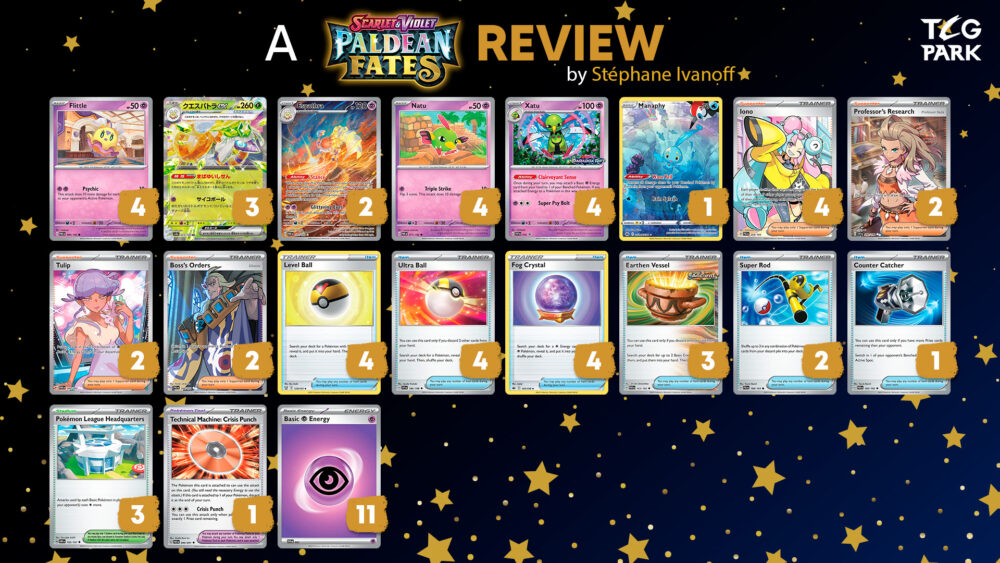
Xatu can accelerate Energy on any Pokémon, which can power up Espathra ex and Espathra. Pokémon League Headquarters is the Stadium of choice to make it even harder for Pokémon like Sableye to attack. This deck also features Technical Machine: Crisis Punch! It can be hard to deal a lot of damage in one turn if you have no Energy on board, so Crisis Punch can fill that role in the late game. Also, thanks to Espathra’s Ability, you can use Crisis Punch on it in the same way as the Mimikyu V combo mentioned above!
Conclusion
As a reprint-heavy small set, Paldean Fates shouldn’t be counted on to revolutionize the metagame. However, cards such as Moonlit Hill and Technical Machine: Crisis Punch will very likely see play, and I wouldn’t be surprised at all if one of them won a Regionals before the next set comes out. Basically, the metagame after February should feel very similar to the current one, but with a little more options!
Thanks for reading as always,
Stéphane